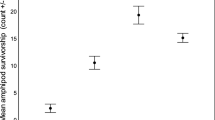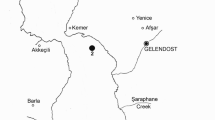Abstract
The introduction of non-indigenous plants, animals and pathogens is one of today’s most pressing environmental challenges. Freshwater ecologists are challenged to predict the potential consequences of species invasions because many ecosystems increasingly support novel assemblages of native and non-native species that are likely to interact in complex ways. In this study we evaluated how native signal crayfish (Pacifastacus leniusculus) and non-native red swamp crayfish (Procambarus clarkii) and northern crayfish (Orconectes virilis) utilize a novel prey resource: the non-native Chinese mystery snail (Bellamya chinensis). All species are widespread in the United States, as well as globally, and recent surveys have discovered them co-occurring in lakes of Washington State. A series of mesocosm experiments revealed that crayfish are able to consume B. chinensis, despite the snail’s large size, thick outer shell and trapdoor defense behaviour. Crayfish exhibited size-selective predation whereby consumption levels decreased with increasing snail size; a common pattern among decapod predators. Comparison of prey profitability curves—defined as the yield of food (weight of snail tissue) per second of feeding time (the time taken to crack the shell and consume the contents)—suggests that small and very large snails may represent the most profitable prey choice. By contrast, previous studies have reported the opposite pattern for crayfish consumption on thin-shelled snails. For all snail size classes, we found that native P. leniusculus and invasive O. virilis consumed greater numbers of snails than invasive P. clarkii. Moreover, P. leniusculus consistently handled and consumed snails at a faster pace compared to both invasive crayfishes across the range of snail sizes examined in our study. These results suggest not only that B. chinensis is a suitable food source for crayfish, but also that native P. leniusculus may ultimately out-consume invasive crayfishes for this new prey resource.






Similar content being viewed by others
References
Alexander JE, Covich AP (1991) Predation risk and avoidance behavior in two freshwater snails. Biol Bull 180:387–393. doi:10.2307/1542339
Bondar CA, Bottriell K, Zeron K, Richardson JS (2005) Does trophic position of the omnivorous signal crayfish (Pacifastacus leniusculus) in a stream food web vary with life history stage or density? Can J Fish Aquat Sci 62:2632–2639
Brown KM (1998) The role of shell strength in selective foraging by crayfish for gastropod prey. Freshw Biol 40:255–260. doi:10.1046/j.1365-2427.1998.00350.x
Bruno JF, Fridley JD, Bromberg KD, Bertness MD (2005) Insights into biotic interactions from studies of species invasions. In: Sax DF, Stachowicz JJ, Gaines SD (eds) Species invasions: insights into ecology, evolution, and biogeography. Sinauer, Sunderland, pp 13–40
Bury JA, Sietman BE, Karns BM (2007) Distribution of the non-native viviparid snails, Bellamya chinensis and Viviparus georganius, in Minnesota and the first record of Bellamya japonica from Wisconsin. J Freshwat Ecol 22:697–703
Byers JE, Reichard SH, Randall JM, Parker IM, Smith CS, Lonsdale WM, Atkinson IAE, Seastedt TR, Williamson M, Chornesky E, Hayes D (2002) Directing research to reduce the impacts of nonindigenous species. Conserv Biol 16:630–640. doi:10.1046/j.1523-1739.2002.01057.x
Carpenter J (2005) Competition for food between an introduced crayfish and two fishes endemic to the Colorado River basin. Environ Biol Fishes 72:335–342. doi:10.1007/s10641-004-2588-z
Chambers PA, Hanson JM, Burke JM, Prepas EE (1990) The impact of the crayfish Orconectes virilis on aquatic macrophytes. Freshw Biol 24:81–91. doi:10.1111/j.1365-2427.1990.tb00309.x
Correia AM (2003) Food choice by the introduced crayfish Procambarus clarkii. Ann Zool Fenn 40:517–528
DeWitt TJ, Robinson BW, Sloan WD (2000) Functional diversity among predators of a freshwater snail imposes an adaptive trade-off for shell morphology. Evol Ecol Res 2:129–148
Dickey BF, McCarthy TM (2007) Predator–prey interactions between crayfish (Orconectes juvenilis) and snails (Physa gyrina) are affected by spatial scale and chemical cues. Invertebr Biol 126:57–66. doi:10.1111/j.1744-7410.2007.00076.x
France KE, Duffy JE (2006) Consumer diversity mediates invasion dynamics at multiple trophic levels. Oikos 113:515–529. doi:10.1111/j.2006.0030-1299.14140.x
Geiger W, Alcorlo P, Baltanas A, Montes C (2005) Impact of introduced crustacean on the trophic webs of Mediterranean wetlands. Biol Invasions 7:49–73. doi:10.1007/s10530-004-9635-8
Gherardi F (2006) Crayfish invading Europe: the case study of Procambarus clarkii. Mar Freshwat Behav Physiol 39:175–191. doi:10.1080/10236240600869702
Gherardi F, Acquistapace P (2007) Invasive crayfish in Europe: the impact of Procambarus clarkii on the littoral community of a Mediterranean lake. Freshw Biol 7:1249–1259. doi:10.1111/j.1365-2427.2007.01760.x
Griffen BD, Guy T, Buck JC (2008) Inhibition between invasives: a newly introduced predator moderates the impacts of a previously established invasive predator. J Anim Ecol 77:32–40. doi:10.1111/j.1365-2656.2007.01304.x
Grosholz ED (2005) Recent biological invasion may hasten invasional meltdown by accelerating historical introductions. Proc Natl Acad Sci USA 102:1088–1091. doi:10.1073/pnas.0308547102
Hobbs WB, Jass JP, Huner JV (1989) A review of global crayfish introductions with particular emphasis on two North American species (Decapoda, Cambaridae). Crustaceana 56:299–316. doi:10.1163/156854089X00275
Hobbs RJ, Arico S, Aronson J, Baron JS, Bridgewater P, Cramer VA, Epstein PR, Ewel JJ, Klink CA, Lugo AE, Norton D, Ojima D, Richardson DM, Sanderson EW, Valladares F, Vilà M, Zamora R, Zobel M (2006) Novel ecosystems: theoretical and management aspects of the new ecological world order. Glob Ecol Biogeogr 15:1–7. doi:10.1111/j.1466-822X.2006.00212.x
Holdich DM (2002) Distribution of crayfish in Europe and some adjoining countries. Bull Fr Peche Piscicult 367:611–650. doi:10.1051/kmae:2002055
Johnson PTJ, Olden JD, Solomon CT, Vander Zanden MJ (2009) Community and ecosystem effects of invasive predators and herbivores in an experimental aquatic system. Oecologia 159:161–170. doi:10.1007/s00442-008-1176-x
Jokinen EH (1982) Cipangopaludina chinensis (Gastropoda, Viviparidae) in North America; review and update. Nautilus 96:89–95
Juanes F (1992) Why do decapod crustaceans prefer small-sized molluscan prey? Mar Ecol Prog Ser 87:239–249. doi:10.3354/meps087239
Krist (2002) Crayfish induce a defensive shell shape in a freshwater snail. Invert Biol 121:235–242
Langsrud Ø (2002) 50-50 Multivariate analysis of variance for collinear responses. Statistician 51:305–317. doi:10.1111/1467-9884.00320
Langsrud Ø, Jørgensen K, Ofstad R, Næs T (2007) Analyzing designed experiments with multiple responses. J Appl Stat 34:1275–1296. doi:10.1080/02664760701594246
Larson ER, Olden JD (2008) Do schools and golf courses represent emerging pathways for crayfish invasions? Aquat Inv 3:465–468. doi:10.3391/ai.2008.3.3.14
Lewis DB, Magnuson JJ (1999) Intraspecific gastropod shell strength variation among north temperate lakes. Can J Fish Aquat Sci 56:1687–1695. doi:10.1139/cjfas-56-9-1687
Light T (2005) Behavioral effects of invaders: alien crayfish and native sculpin in a California stream. Biol Inv 7:353–367. doi:10.1007/s10530-004-2510-9
Lockwood JR (1998) On the statistical analysis of multiple-choice feeding preference experiments. Oecologia 116:475–481. doi:10.1007/s004420050612
Lodge DM, Lorman JG (1987) Reductions in submersed macrophyte biomass and species richness by the crayfish Orconectes rusticus. Can J Fish Aquat Sci 44:591–597. doi:10.1139/f87-072
Lodge DM, Kershner MW, Aloi JE, Covich AP (1994) Effects of an omnivorous crayfish (Orconectes rusticus) on a freshwater littoral food web. Ecology 75:1265–1281. doi:10.2307/1937452
Lodge DM, Williams SL, MacIsaac H, Hayes K, Leung B, Reichard S, Mack RN, Moyle PB, Smith M, Andow DA, Carlton JT, McMichael A (2006) Biological invasions: recommendations for US policy and management. Ecol Appl 16:2035–2054. doi:10.1890/1051-0761(2006)016[2035:BIRFUP]2.0.CO;2
MacIsaac HJ (1994) Size-selective predation on zebra mussels (Dreissena polymorpha) by crayfish (Orconectes propinquus). J N Am Benthol Soc 13:206–216. doi:10.2307/1467239
Mack RN, Simberloff D, Lonsdale WM, Evans E, Clout M, Bazzaz FA (2000) Biotic invasions: causes, epidemiology, global consequences, and control. Ecol Appl 10:689–710. doi:10.1890/1051-0761(2000)010[0689:BICEGC]2.0.CO;2
Mackie GL (1999) Introduction of molluscs through the import for live food. In: Claudi R, Leach J (eds) Non-indigenous freshwater organisms: vectors biology and impacts. Ch 1. Lewis Publishers, Boca Raton
Magoulick DD, Lewis LC (2002) Predation on exotic zebra mussels by native fishes: effects on predator and prey. Freshw Biol 47:1908–1918. doi:10.1046/j.1365-2427.2002.00940.x
Martin GW, Corkum LD (1994) Predation of zebra mussels by crayfish. Can J Zool 72:1867–1871. doi:10.1139/z94-254
McCarthy JM, Hein CL, Olden JD, Vander Zanden MJ (2006) Coupling long-term studies with meta-analysis to investigate impacts of non-native crayfish on zoobenthic communities. Freshw Biol 51:224–235. doi:10.1111/j.1365-2427.2005.01485.x
Mueller KW (2001) First record of the red swamp crayfish, Procambarus clarkii (Girard, 1852) (Decapoda, Cambaridae), from Washington state, USA. Crustaceana 74:1003–1007. doi:10.1163/15685400152682737
Nilsson PA, Nilsson K, Nyström P (2000) Does risk of intraspecific interactions induce shifts in prey-size preference in aquatic predators? Behav Ecol Sociobiol 48:268–275. doi:10.1007/s002650000235
Nyström P, Pérez JR (1998) Crayfish predation on the common pond snail (Lymnaea stagnalis): the effect of habitat complexity and snail size on foraging efficiency. Hydrobiologia 368:201–208. doi:10.1023/A:1003266603371
Nyström P, Brönmark C, Granéli W (1996) Patterns in benthic food webs: a role for omnivorous crayfish? Freshw Biol 36:631–646. doi:10.1046/j.1365-2427.1996.d01-528.x
Nyström P, Brönmark C, Granéli W (1999) Influence of an exotic and a native crayfish species on a littoral benthic community. Oikos 85:545–553. doi:10.2307/3546704
Parker IM, Simberloff D, Lonsdale WM, Goodell K, Wonham W, Kareiva PM, Williamson MH, Von Holle B, Moyle PB, Byers JE, Goldwasser L (1999) Impact: towards a framework for understanding the ecological effects of invaders. Biol Inv 1:3–19. doi:10.1023/A:1010034312781
Pflieger WL (1996) The crayfishes of Missouri. Missouri Department of Conservation, Jefferson City
Prince JS, LeBlanc WG, Maciá S (2004) Design and analysis of multiple choice feeding preference data. Oecologia 138:1–4. doi:10.1007/s00442-003-1413-2
Raffa KF, Havill NP, Nordheim EV (2002) How many choices can your test animal compare effectively? Evaluating a critical assumption of behavioral preference tests. Oecologia 133:422–429. doi:10.1007/s00442-002-1050-1
Robinson JV, Wellborn GA (1988) Ecological resistance to the invasion of a fresh-water clam, Corbicula fluminea: fish predation effects. Oceologia 77:445–452. doi:10.1007/BF00377258
Saffran KA, Barton DR (1993) Trophic ecology of Orconectes propinquus (Girard) in Georgian Bay (Ontario, Canada). Freshwat Crayfish 9:350–358
Sanderson BL, Barnas KA, Rub MW (2009) Non-indigenous species of the Pacific Northwest: an overlooked risk to endangered salmon? Bioscience 59:245–256. doi:10.1525/bio.2009.59.3.9
Sih A, Christensen B (2001) Optimal diet theory: when does it work, and when and why does it fail? Anim Behav 61:379–390. doi:10.1006/anbe.2000.1592
Sin TS (2006) Evaluation of different species of fish for biological control of golden apple snail Pomacea canaliculata (Lamarck) in rice. Crop Prot 25:1004–1012. doi:10.1016/j.cropro.2006.01.012
Söderbäck B (1995) Replacement of the native crayfish Astacus astacus by the introduced species Pacifastacus leniusculus in a Swedish lake: possible causes and mechanisms. Freshw Biol 33:291–304. doi:10.1111/j.1365-2427.1995.tb01168.x
Stachowicz JJ, Whitlatch RB, Osman RW (1999) Species diversity and invasion resistance in a marine ecosystem. Science 286:1577–1579. doi:10.1126/science.286.5444.1577
Strayer DS, Eviner VT, Jeschke JM, Pace ML (2006) Understanding the long-term effects of species invasions. Trends Ecol Evol 21:645–651. doi:10.1016/j.tree.2006.07.007
Thayer SA, Haas RC, Hunter RD, Kushler RH (1997) Zebra mussel (Dreissena polymorpha) effects on sediment, other zoobenthos, and the diet and growth of adult yellow perch (Perca flavescens) in pond enclosures. Can J Fish Aquat Sci 55:1903–1915. doi:10.1139/cjfas-54-8-1903
Usio N, Konishi M, Nakano S (2001) Species displacement between an introduced and a “vulnerable” crayfish: the role of aggressive interactions and shelter competition. Biol Inv 3:179–185. doi:10.1023/A:1014573915464
Usio N, Nakata K, Kawai T, Kitano S (2007) Distribution and control status of the invasive signal crayfish (Pacifastacus leniusculus) in Japan. Jap J Limnol 68:471–482. doi:10.3739/rikusui.68.471
Vander Zanden MJ, Olden JD (2008) A management framework for preventing the secondary spread of aquatic invasive species. Can J Fish Aquat Sci 65:1512–1522. doi:10.1139/F08-099
Vinson MR, Baker MA (2008) Poor growth of rainbow trout fed New Zealand mud snails Potamopyrgus antipodarum. N Am J Fish Manage 28:701–709. doi:10.1577/M06-039.1
Warner GF (1996) Factors affecting the selection of pond snail prey by signal crayfish. Freshwat Crayfish 11:194–202
Warner GF, Wood JC, Orr-Ewing RH (1995) Signal crayfish (Pacifastacus leniusculus) feeding on pond snails: optimal foraging? Freshwat Crayfish 8:352–359
Wood WM (1892) Paludina japonica mart. for sale in the San Francisco Chinese markets. Nautilus 5:114–115
Acknowledgments
We thank Jeff Benca, Brandi Olden and Juliette Olden for helping conduct the experiments and Jon Wittouck for assisting in the assembly of the mesocosms. ERL was supported by an Achievement Rewards for College Scientists Foundation scholarship, Victor and Tamara Loosanoff Fellowship, and a Nancy Weller Memorial scholarship from the Washington State Lake Protection Association. MCM was supported by a John N. Cobb Scholarship in Fisheries and a Graduate School Top Scholar Award from the University of Washington. JDO conceived and developed the idea for the manuscript and conducted the data analysis, and JDO, ERL and MCM conducted the experiment and wrote the manuscript.
Author information
Authors and Affiliations
Corresponding author
Rights and permissions
About this article
Cite this article
Olden, J.D., Larson, E.R. & Mims, M.C. Home-field advantage: native signal crayfish (Pacifastacus leniusculus) out consume newly introduced crayfishes for invasive Chinese mystery snail (Bellamya chinensis). Aquat Ecol 43, 1073–1084 (2009). https://doi.org/10.1007/s10452-009-9244-9
Received:
Accepted:
Published:
Issue Date:
DOI: https://doi.org/10.1007/s10452-009-9244-9




